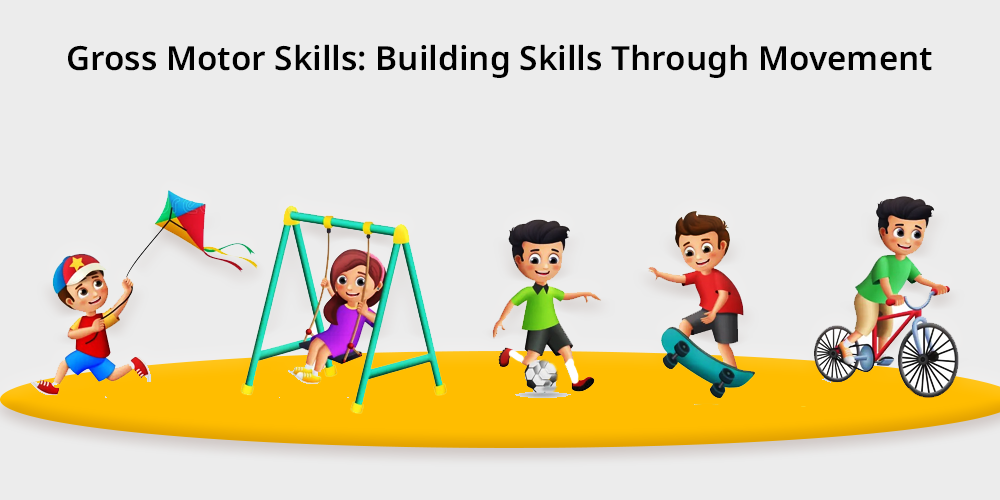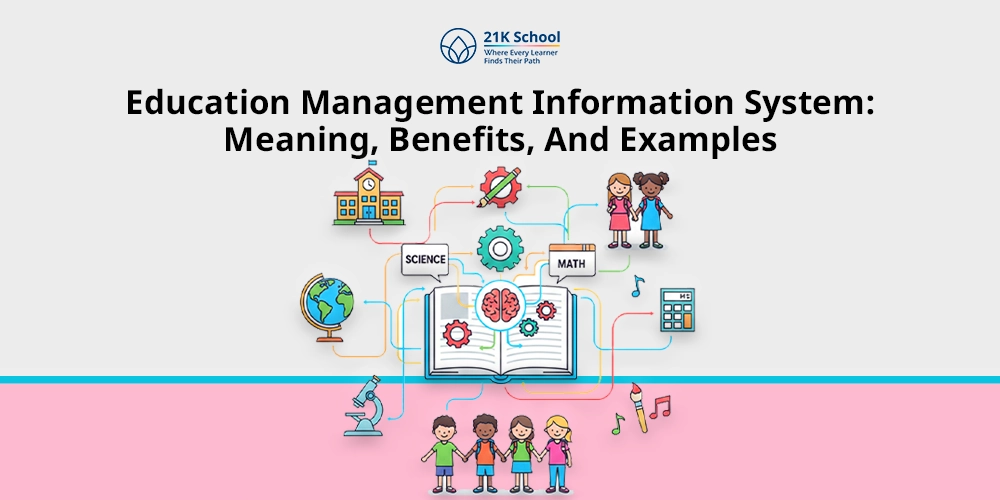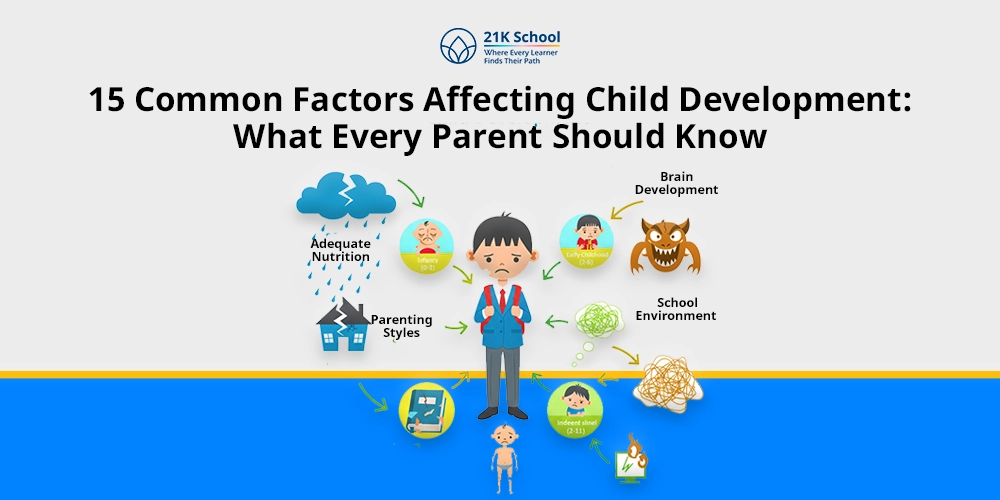
Have you ever thought about the skills that make kids stronger from infancy?
If not, this is the right time to explore and understand everything about gross motor skills. Skills that are crucial for body awareness, balance, and coordination.
With time children learn different movements and activities in their daily life. From taking the first step as toddler to mastering the art of catching a ball.
Gross motor skill activities play a crucial role in overall development. Understanding motor skills and how it works to make children healthy.
Contents
- What Are Gross Motor Skills?
- Why Are Gross Motor Skills Essential in Early Childhood Development?
- Importance of Gross Motor Skills
- Common Challenges in Gross Motor Skills
- 10 Popular Activities to Support Gross Motor Development
- Tips for Parents and Teachers to Develop Gross Motor Skills in Children
- Over to You: Encourage Your Child to build lifelong abilities
What Are Gross Motor Skills?
Gross motor skills refers to movement in large muscles which includes the entire body enabling various activities such as climbing, walking and jumping.
These essential activities help in enhancing daily life physical work which requires coordination, balance and focus.
If you are looking for exact definition:
Gross motor skills is a movement that utilises large muscles like arms and legs to gain strength in the whole body.
Some of the ideal examples gross motor skill activity are:
- Jumping and hopping
- Climbing stairs
- Throwing and catching a ball
- Riding a bicycle
- Dancing or freeze dance
- Pulling and pushing
- Running or relay race
These are the common or foundation gross motor skills activities for students. Here we will understand much more elaborated points on gross motor skills.
This blog showcases why parents and teachers should add gross motor skills in kids’ daily activities.
Why Are Gross Motor Skills Essential in Early Childhood Development?
Gross motor skills are essential in early childhood development because it helps to achieve the foundation of physical activities, cognitive development and social interactions.
Whether you are a teacher, parent or close relative, support children to become confident and physically active with gross motor skills.
In early childhood, gross motor skills support in achieving physical strength and give a chance to explore surrounding and creative thinking skills.
As per research these skills are directly related to mental health development coordination and overall wellness.
Here are some detail understanding why it is so much important for kids:
- Everyday Function: Gross motor skills in early childhood is the foundation of basic movements like walking, jumping and running.
The skills guide in balance, coordination and make kids participate in various activities. It is also helpful in developing fine motor skills. - Sports and Leisure: Gross motor skills are essential for every child because they form the basics for physical activity, coordination, and participation in sports and leisure.
These skills motivate them to perform everyday tasks, engage in play, and develop their overall physical health and well-being. - Brain Growth: Gross motor skills activity improves students in growth and mental health development. By strengthening neural connections it improves critical thinking abilities.
- Problem-Solving Skills: With gross motor skills activities children build problem solving skills and communication skills with teachers and other students.
By understanding challenges and finding solutions to answer the question, students look for innovative ideas. - Language Development: Gross motor skills is a foundation of many physical and mental development of children. Language development is one of the popular ones.
- Posture and Balance: Gross motor skills directly impact on kids posture, balance, and overall physical development. It enables smooth movement without any obstacle or hurdle. Children can learn everything while playing indoor and outdoor gross motor activities.
These points showcase gross motor skills is not only for physical activities it is equally important for cognitive social and emotional development.
Encourage children to implement these skills in daily life for healthy growth and development.
Importance of Gross Motor Skills
Gross motor skills are a basic need for overall development, enabling large muscle movements crucial for daily activities.
Let’s explore the importance of gross motor skills in depth-
1. Physical Development
Physical development is enabling children to perform everyday tasks, explore their environment, and participate in activities like sports.
Children at an early age starting with basic motor skills become stronger.
2. Everyday Function
Everyday function in gross motor skills means doing simple daily tasks. Children who develop these skills efficiently can perform routine activities with confidence.
It enables large-scale movements which support independence in tasks such as dressing for school, walking to school, or participating in sports.
3. Building Blocks for Fine Motor Skills
As per various research gross motor skills is a building block of fine motor skills.
Fine motor skills, refers to manipulating small objects with precision, are essential for tasks like writing, drawing, and using tools.
To know more learn 10 essential fine motor skills activities for Young Learners.
4. Increased Independence
Gross motor skills work for physical and mental development of children. However it also contributes significantly to their independence.
With the right skills children gain the ability to move freely, balance effectively and coordination which leads to independence.
5. Social Interaction
Through social interactions children participate in play and other activities with friends, fostering cooperation, communication skills, and a sense of belonging.
Social interaction develops social emotional skills which contribute to a child’s success.
6. Improved Confidence
Master in gross motor skills can gain a sense of achievement and independence, fostering a more positive self-image.
Common Challenges in Gross Motor Skills
While learning any kind of skill, challenges are common. As we know every child develops at their own pace.
They feel difficulties in learning new things like gross motor skills. This could indicate a need for additional support by parents and teachers.
Early detection of gross motor skills challenges ensures timely intervention and better outcomes for kids.
Let’s elaborate each point for your better understanding:
1. When to Seek Help
Seeking professional help is important when a child consistently delays reaching gross motor milestones.
Activities like sitting, crawling, or walking, or displays other signs like clumsiness, difficulty with balance, or avoidance of physical activity.
2. Balancing
Balancing gross motor skills is a challenging part in which kids need to maintain posture and controlling movements.
These challenges create obstacles for students to fulfill their daily tasks like complex homework and playing games.
3. Clumsiness and Incoordination
Some challenges with balance, coordination, and movement, often leads to clumsiness or awkwardness in kids.
This can happen due to neuro developmental conditions like dyspraxia.
4. Difficulties with Sequencing
Difficulties with sequencing is one of the common problems in planning and executing movements that require a series of steps or actions.
This challenge is connected to many factors such as delay in development, sensory processing issues and coordination problems.
5. Muscle Weakness or Tone
Muscle weakness or tone also impact gross motor skills. Many kids who are facing muscle weakness are unable to perform these skills correctly.
However, dealing with diseases like hypotonia can be the reason that affects coordination, balance, and stability.
6. Sensory Processing
Children with sensory processing challenges may avoid movement or appear overly sensitive to touch, noise, or movement.
This can affect their desire or ability to be involved in gross motor activities.
7. Developmental Delay
Developmental delay happens when children constantly miss the foundation or basic gross motor skills activities in childhood.
There are various reasons such as genetic conditions, neurological issues, or structural problems etc. Teachers and parents should not avoid and seek help if needed.
It is important to understand when to seek professional help if the child is facing difficulties doing gross motor skills activities.
If you are noticing any kind of difficulties in developing gross motor skills connect with the health care specialist to understand better.
Remember early detection and professional contribution help children to overcome the situation and improve overall health.
10 Popular Activities to Support Gross Motor Development
There are many popular activities to support gross motor development in children. From playground play, dancing, swimming, biking, and playing sports etc.
These activities are ideal for kids from infant to adult which improve body strength and health in mental balance in each stage of life.
Let’s understand be popular gross motor skills activities and why it is advantageous for kids:
1. Playground Activities
From childhood every child loves to go to the playground to play different kinds of activities. Some playground activities are climbing, jumping, running and cycling.
These activities engage students for gross motor skills development and improve overall physical fitness.
- Swinging: Swimming improves balance and core strength as childrens coordinate body movements.
- Climbing structures: It helps in coordination, grip strength, and spatial awareness in the body.
- Sliding: A popular game for kids ideal for understanding body positioning and fosters courage and balance.
- Running and chasing games: Most of the kids start with running towards each other. It builds stamina, leg strength, and agility.
2. Obstacle Courses
Obstacle courses include fun and challenging activities in which a series of physical challenges made by kids or elders to tackle based on thinking.
This requires coordination, balance, and problem-solving skills. It is an ideal gross motor skill for children. Some common examples are.
- Jumping over hurdles: Kids start jumping over the hurdles which develops leg strength and timing.
- Crawling through tunnels: By crawling under the tunnels or tunnel-like obstacles helps in strengthening the upper body and improves coordination.
- Balancing on beams: Balancing on beams encourages child’s core stability and focus which leads to future fitness.
- Weaving through cones: Weaving through cones means speed running through obstacles which improves focus, agility and directional awareness.
3. Ball Games
In gross motor skill activities there are different kinds of ball games for example ball throwing, catching, and kicking.
These love students to improve skills like hand-eye coordination, leg strength, and overall motor planning. Let’s see some common ball games for child development:
- Throwing and catching: Adding activities like Throwing and catching the ball develops hand and eye coordination.
- Kicking a ball: For strengthening the leg muscles and balance kids can go with ball kicking gross motor skills.
- Dribbling (basketball or soccer): Dribbling enhances control, concentration, and coordination in children.
- Group games like dodgeball and kickball: Group games like dodgeball foster strategic thinking and student to student social interaction in the school playground.
4. Homemade Obstacle Course
Playing fun and engaging homemade obstacle courses boasts children’s gross motor skills. It is also played as an Indoor gross motor skills activity.
Some of the popular activities are creating tunnels to crawl through, using items like pillows, blankets, or chairs to jump over or around, and balancing on a beam or line.
- Use cushions as jumping pads: Create simple games to build leg power and balance.
- Create tunnels with blankets and chairs: By making hurt, tunnels through blankets will encourage crawling and spatial navigation in kids.
- Tape on floor for hopping or balancing: To enhance stability and foot control in kids parents use taping on floor in which kids walk and balance.
- Arrange toys or books to weave around: By arranging everything in the room is a gross motor skills activity which teaches direction change and body control.
5. Puzzle
Same as other gross motor skills activities, puzzle games encourage children to use their both mind and body development.
Some common puzzle children may like to play in home or classroom are:
- Scavenger puzzle hunt: In this game parents or teachers hide puzzle pieces around a room or yard. Later children think, walk, crawl, or jump to retrieve each piece.
- Large floor puzzles: Large floor puzzles require whole-body movements as children reach, stretch, and move across spaces. It also engages children’s minds for a longer time.
- Puzzle relay: Place puzzle stations at intervals and have kids run or hop to each one can be an ideal game.
6. Dancing or Dance party
Dancing or dance parties is an activity to promote gross motor skills in children, as they require coordination, balance, and movement.
This activity is not only good for body movement but also works as a zumba exercise for kids. Play music to make it engaging.
- Free dancing to music: In this type kids are open to do any dance style. It encourages creativity, flexibility, and whole-body movement.
- Follow-the-leader dances: Here kids follow the exact steps of the leader in the game which improve listening skills, imitation, and sequencing.
- Group dance routines: In group dance each student develops coordination, memory, and social interaction with each other.
7. Martial Arts
Martial arts includes karate, taekwondo, or judo which is ideal for students’ discipline and strength.
Movement in martial arts consist of punching, kicking, grappling etc. It provides extraordinary muscle strength and balance and stability.
- Kicks and punches in competition: It is the basic martial arts which improve balance, muscle strength, and coordination together.
- Different forms or katas: With the help of different forms or katas teach sequencing, focus, and body control.
- Partner drills: partner drills is a one-to-one game between two kids. It promotes cooperation, timing, and spatial awareness.
8. Hula Hoop
Hula hoop is a versatile and multitasking tool used to develop gross motor skills in kids.
The activities of hula hoop include jumping over hoops, hopping within them, and spinning them around the body. It enhances balance, and core strength.
- Waist hooping: To build core stability and hip coordination students can try wrist hopping. Pair with friends and give the maximum round challenge.
- Jumping in and out: Here kids place the hoops in the ground and jump in and out. The movement enhances agility, balance, and leg strength.
- Rolling and chasing the hoop: With a stick or other object kids roll the hoop and then chase it to stop it or change its direction. This encourages their speed, direction change, and hand-eye coordination.
9. Balloon and Bubble Play
Balloon and bubble play is a game in which children run towards a balloon or bubble to ensure it doesn’t touch the ground.
Movements like running, jumping and hand waving leads to gross motor skills development in kids.
- Chasing and popping bubbles: By chasing and popping bubbles a child can improve visual tracking, agility, and timing.
- Keeping a balloon in the air: kids ensure that balloon doesn’t fall and this activity builds their arm coordination and body movement control.
- Bubble obstacle games: In this activity kids shoot bubbles after overcoming obstacles. The game is a combination of movement challenges with visual focus.
10. Nature Walks and Treasure Hunts
Nature walks and treasure hunts refer to the movement of kids in search of new places and finding treasures.
Walking on tricky roads, hunting every corner and facing obstacles make this activity a perfect way to improve gross motor skills.
Here are some fun ways:
- Walking on uneven terrain: If kids try to walk on tricky roads it develops balance and lower-body strength.
- Bending, reaching, and squatting: Picking treasure, reaching every corner for search will improve the flexibility and gross motor planning.
- Climbing small hills or logs: Climbing small hills or logs will build endurance, agility, and risk assessment skills.
Each gross motor skills activity will guide kids towards a better and healthy future. The need is just for some awareness and active body movement.
Tips for Parents and Teachers to Develop Gross Motor Skills in Children
Parents and teachers play a major role in the development of gross Motor skills in children.
From choosing different indoor and outdoor activities by parents to encourage children for daily practice to physical classes in school to enhance playground activities.
Both teacher and parent need full attention on what children are doing to improve their physical and mental health.
Read more about mental health activities to improve gross motor skills in kids.
Here are some tips for parents and children to develop gross motor skills in kids with easy and playful way:
- Encourage Active Play: Different kinds of active play helps in encouraging gross motor skill development.
There are different structured activities like sports and dance, and unstructured outdoor play like running, climbing, and playing on playground equipment leads to active play. - Structured Activities: Structure activities need both parent and teacher attention to detail. These games should be age appropriate.
Having a safe environment with structured play opportunities like gymnastics, dance, martial arts, or swimming is ideal. - Create Movement-Oriented Environments: Whether students are at home or in the classroom, they create stimulating and safe environments, both indoors and outdoors, that encourage movement and exploration. This will enhance motor skill development without any hurdles.
- Incorporate Games and Activities: Always remember to incorporate different kinds of games and activities to maintain their interest in gross motor skills development. For example fun games like “Simon Says,” musical chairs, or scavenger hunts to sneak in physical activity.
Gross motor skills activities have a lot of different engaging games for children. Remember to rotate activities weekly or twice a week.
This will help in keeping them fresh and engaging while targeting different motor skills.
Over to You: Encourage Your Child to build lifelong abilities
Gross motor skills are childhood milestones which need parents and teachers guidance in early stages. These activities are essential tools for a child’s life.
It’s time to support each child in their physical development through fun, engaging, and age-appropriate activities.
Teachers and parents are laying the foundation for their confidence, independence, and overall well-being.
So, it’s time to encourage that next jump, cheer for every climb, and celebrate each new skill.
Are you ready to explore the world in a new way, remember one movement at a time.



